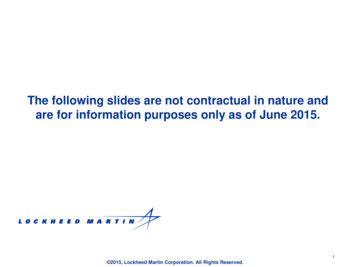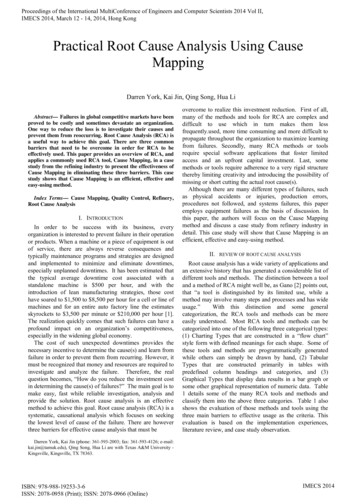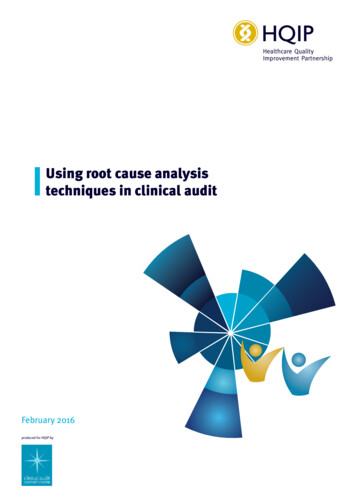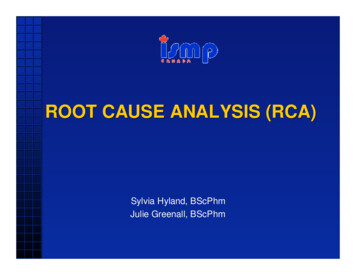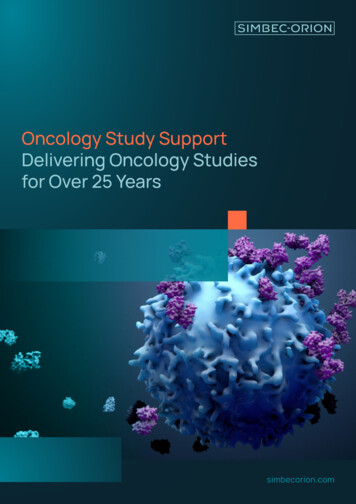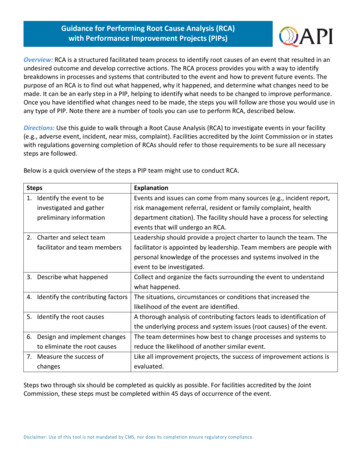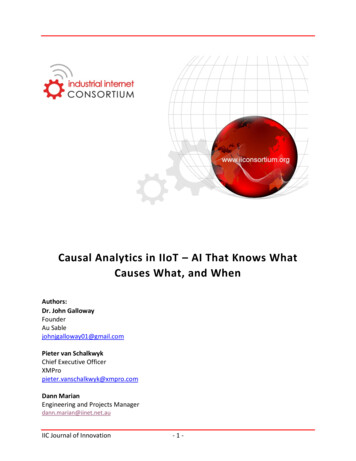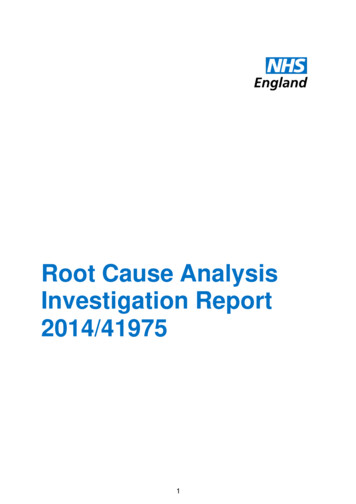
Transcription
De Búrca Rare BooksA selection of fine, rare andimportant books and manuscriptsCatalogue 140Autumn2019
DE BÚRCA RARE BOOKSCloonagashel,27 Priory Drive,Blackrock,County Dublin.01 288 215901 288 6960CATALOGUE 140Autumn 2019PLEASE NOTE1. Please order by item number: Wilde is the code word for this catalogue which means:“Please forward from Catalogue 140: item/s .”.2. Payment strictly on receipt of books.3. You may return any item found unsatisfactory, within seven days.4. All items are in good condition, octavo, and cloth bound, unless otherwise stated.5. Prices are net and in Euro. Other currencies are accepted.6. Postage, insurance and packaging are extra.7. All enquiries/orders will be answered.8. We are open to visitors, preferably by appointment.9. Our hours of business are: Mon. to Fri. 9 a.m.-5.30 p.m., Sat. 10 a.m.- 1 p.m.10. As we are Specialists in Fine Books, Manuscripts and Maps relating to Ireland,we are always interested in acquiring same, and pay the best prices.11. We accept: Visa and Mastercard.There is an administration charge of 2.5% on all credit cards.12. All books etc. remain our property until paid for.13. Text and images copyright De Burca Rare Books.14. All correspondence to 27 Priory Drive, Blackrock, County Dublin.TelephoneFaxe-mailweb site(01) 288 2159. International 353 1 288 2159(01) 288 6960. International 353 1 288 6960(01) 283 4080. International 353 1 283 .comCOVER ILLUSTRATIONS:Our front cover illustration is taken from item 430, a fine, signed photograph of Oscar Wilde.Inside covers are illustrated by items 8, Baldoyle Races and item 93, Dublin Fusiliers. The lowercover is illustrated with a watercolour of Anne McGarahan from item 281, James Mongan'sReport of the Trial.ii
Catalogue 140NANGLE AND THE ACHILL MISSION1. [ACHILL MISSION] The Achill Mission, and the Present State of Protestantism in Ireland:being The Statement delivered by Rev. Edward Nangle, at a meeting of the ProtestantAssociation, in Exeter Hall, December 28, 1839. pp. 28. Together with: Statement of Views andObjects, Fundamental Resolutions, and Rules, 21 other pamphlets, 4 handbills and First-ThirdAnnual Report, 1837-1839 [of various reissued editions] of the Protestant Association, Volume1. Includes papers by the Bishop of Exeter, the Revd's Dr. Crolly, Dr. Holloway, H. Melvill, R.Monro, Hugh McNeile, R.J. McGhee, and Edward Nangle, J.C. Colquhoun, Esq. M.P., and G.H.Woodward, Esq. A.B. London: Published by the Protestant Association, 1839. Original clothrebacked A very good copy. 575The contents include: The Uses of the Established Church to the Protestantism and Civilisation ofIreland; Statement of the Circumstances attending the Publication of the Bible with the Rhemish Notes,in Dublin, 1813-16 and in Cork, 1818; The Doctrines promulgated by the Romish Bishops in Ireland,touching the power of the Romish Church over heretics - etc.; Roman Catholic Oath. Speech of theBishop of Exeter - on presenting a petition from certain inhabitants of Cork; A Letter to the Duke ofWellington; The Popish College of Maynooth, etc.The Protestant Association [later the British Society for Promoting Religious Principles of theReformation] was founded in 1827, publishing vehement Anti-Catholic propaganda from the radicallyconservative wing of Anglican Evangelicalism.Edward Nangle the 'Apostle of Achill' (1799-1883), founded a Protestant Missionary Colony in 1831.The land on which the Achill colony was built was leased from the island’s landlord, Sir RichardO’Donnell, and was located near the village of Dugort, under the shadow of Achill’s highest mountain,Slieve Mór. His settlement flourished and he founded there a school, a church, a hospital and a printingpress from which flowed numerous tracts, pamphlets and articles for his propagandist newspaper, theAchill Missionary Herald and Western Witness, in which he attacked the 'superstition and idolatry ofthe Church of Rome'. This incurred the wrath of both the Catholic and Protestant clergy. The Colonyflourished and numbers flocked to his congregation. The Catholic church was soon reminded of itsneglect of the West of Ireland, and the early successes of the mission spurred it into action. The turningpoint came in 1837 when the Catholic Archbishop of Tuam, John MacHale, visited the Island andstirred up the populace against what he called ‘these venomous fanatics’. The Achill Herald recountsan incident during MacHale’s visit to neighbouring Clare Island when a scripture reader and aschoolmaster from the mission were beaten and pursued ‘almost to the death’ by the locals, and had toflee the island by night to save their lives. The arrival of Father John Dwyer, appointed by JohnMacHale, as parish priest of Achill, heralded a sustained attack on the colony, its staff and supporters.Caesar Otway’s biased but evocative description of these early attacks on the mission give us a feel forthe passions aroused on both sides. In A Tour in Connaught (1839), he relates a sermon preachedagainst the mission by Fr Dwyer: "Have nothing to do with these heretics - curse them, hoot at them,spit in their faces - cut the sign of the cross in the air when you meet them, as you would against devils- throw stones at them - pitch them, when you have opportunity, into the bog holes . don’t take anymedicine from their heretic doctor [Neason Adams], rather die first."2. ANDREWS, C.S. Dublin Made Me. An Autobiography. Dublin & Cork: Mercier Press: 1979.First edition. pp. 312. Green papered boards, titled in gilt. Signed presentation copy from ToddAndrews, with one date correction by the author (1921 crossed out - should read 21 Nov. 1920).A fine copy in fine dust jacket with a few nicks. 95In this work Andrews describes the surge of nationalism and the making of a revolutionary. Heparticipates in street fighting against the British, is jailed and escapes from internment. His stanceagainst the Treaty and his experiences of the Civil War make as fine an account of this period.RARE CORK PRINTING3. ANON A Chronological Epitome of the Most Remarkable Events that have occurred duringthe French Revolution from 1789-1796. Cork: Printed by Daly and Travers, No. 16 St. PatrickStreet. 12mo. pp. [2], 134. Modern half calf on cloth boards, titled in gilt on upper cover. Paperrepair to margin of titlepage and first leaf. A very good copy. Extremely rare. 875ESTC T218016 with 2 locations only. WorldCat 1.Price on titlepage: Price One Shilling & Seven-pence Halfpenny.1
De Búrca Rare BooksA HAPPY PARSON'S BOOK WITH HAND-COLOURED ILLUSTRATIONS4. AN OXONIAN [S. Reynolds Hole]. A Little Tour in Ireland. Being a Visit to Dublin,Galway, Connemara, Athlone, Limerick, Killarney, Glengarriff, Cork, etc. With colouredfrontispiece and hand-coloured illustrations by John Leech. London: Bradbury & Evans, 1859.Small quarto. pp. viii, 220. Bound in the style of Birdsall of Northampton and London in fulldark green calf. Covers decorated with double gilt fillets. Spine divided into six panels by fivegilt raised bands, title and illustrator in gilt in the second and third, the remainder blocked in giltwith a floral device in centre; corners of board edges hatched in gilt; turn-ins gilt; red and goldendbands; splash-marbled endpapers. With an exquisite bookplate depicting a Tudor-style librarywith a view of a church and rectory from an open door, with the legend: 'This is the book ofCharles Lewis Slattery a happy Parson'. All edges gilt. Superb copy in pristine condition. 1,250Woods 147.Samuel Reynolds Hole (1819-1904) Anglican priest, author and horticulturalist was born at Ardwick,near Manchester (where his father was then in business), was only son of Samuel Hole, of CauntonManor, Nottinghamshire, by his wife Mary, daughter of Charles Cooke of Macclesfield. Afterattending Mrs. Gilbey's preparatory school at Newark, he went to Newark grammar school. Of literarytastes, he edited at sixteen a periodical called The Newark Bee.Educated at Brasenose College, Oxford, he was ordained in 1844 and spent 43 years at his father'sparish of St. Andrew's Church, Caunton, firstly as curate and from 1850 as its vicar. A prebendary ofLincoln Cathedral and an honorary chaplain to Edward Benson, the then Archbishop of Canterbury, hebecame Dean of Rochester in 1887. Noted for his expertise with roses and an inaugural recipient of theRoyal Horticultural Society's Victoria Medal of Honour.2
Catalogue 140In 1858 Hole came to know John Leech, and a close friendship followed. In the summer of 1858 thetwo, who often hunted together, made a tour in Ireland, of which one fruit was Leech's illustratedvolume, A Little Tour in Ireland (1859), with well-informed and witty letterpress by Oxonian (i.e.Hole). A reprint of 1892 gives Hole's name as author. Of Limerick Hole recollected: "Limerick isdivided into three parts, the Irish town, the English town, and Newtown Perry (so called after a Mr.Sexton Perry, who commenced it); and these are connected by bridges, of which the old Thomond,hard by King John's Castle, and new Wellesley, said to have cost 85,000l, are interesting. Theeccentricities of the workmen must have added materially to the costliness of the latter structure,inasmuch as they seem to have been Odd Fellows as well as very Free Masons, who, instead ofcementing stones and friendships, only turned the former into stumbling blocks for the latter, bythrowing them at each other's heads. Every day an animated faction-fight, between the boys of Clareand the boys of Limerick, was got up (instead of the bridge), until at length it was necessary to bringout an armed force, to keep order on this Pons Asinorum. The main street of Newtown Perry, in whichis Cruise's Hotel, is a long and handsome one; and what's more, you may buy some good cigars in it, arare refreshment in Ireland."In Galway they met a waiter who gave them a first-hand account of the famine: "Ah, but we felt almostashamed of being so full and comfortable, when our conversational attendant began to talk to us aboutthe Great Famine. 'That's right, good gentleman,' he said, 'niver forget, when ye've had your males, tothank the Lord as sends them. May ye niver know what it is to crave for food, and may ye niver seewhat I have seen, here in the town o' Galway. I mind the time when I lived yonder' (and he pointed toKilroy's Hotel), 'and the poor craturs come crawling in from the country with their faces swollen, andgrane, and yaller, along of the arbs they'd been atin.' We gave them bits and scraps, good gintlemen,and did what we could (the Lord be praised!), but they was mostly gone too far out o' life to want morethan the priest and pity. I've gone out of a morning, gintlemen,' (his lip quivered as he spoke), 'and seenthem lying dead in the square, with the green grass in their mouths.' to hide the tears which did him somuch honour."5. ARENSBERG, Conrad M. & KIMBALL, Solon T. Family and Community in Ireland.Illustrated with figures, tables & maps. Cambridge: Harvard U.P. 1968. Second edition. pp. xxiii,417. Beige buckram, title in black on spine. Signature of the Historian, Ronan Fanning on frontfree endpaper. A very good copy in frayed dust jacket. 75This edition includes six new chapters on the behaviour of Irish townsmen and the distinctions betweenurban and rural life, even as the two remain intimately linked.THOSE WHO SUFFERED FOR THE PROTESTANT FAITHINCLUDING THE MASSACRE OF THE PROTESTANTS IN IRELAND IN 16416. [ARMY OF MARTYRS] The Noble Army of Martyrs. Broadside. Illustrated with engravedvignettes. 375 x 500mm. London: Catnach, n.d. (c.1830). Creased from folding. In very goodcondition. Extremely rare. 375No copy located on COPAC. WorldCat 1.In his notice to the reader the anonymous author states: "Popery is not only the worst religion, but thegreatest evil that can possibly come into any country. Should any endeavour to persuade thee, reader,that popery now is different from it was in the reign of Q. Mary thou mayest answer, Yes, there is thesame difference as between a lion chained up, and a lion let loose. Popery does not burn Protestants todeath in Smithfield now, because it hath not power. Be assured that popery is always the same, and sowill continue, until it shall cease out of the earth . ."The engraved vignettes around the border depict: The Martyrdom of Dr. Thomas Cramer at Oxford,March 21, 1556; The Burning of Dr. John Hooper, at Gloucester, Feb. 9, 1555; The Burning of Dr.Robert Farrar, at Carmarthen, Feb. 22, 1555; Martyrdom of The Rev. R. Drakes, Rev. W. Tyms, orSpunge, T. Spunge, J. Cavel, and G. Ambrose, in Smithfield; Horrible Martyrdom of a Mother and hertwo Daughters; Burning of Mrs. Agnes Bangeor, and Mrs. Margaret Thurson, at Chichester;Martyrdom of the Rev. Rowland Taylor, at Hadley, Suffolk, Feb. 9, 1555; Burning of W. Coker, W.Hopper, H. Laurence, R. Colliar, R. Wright, & W. Steer; Martyrdom of St. Laurence; Massacre of theProtestants in Ireland in 1641.In the centre are three large vignettes: The Noble Army of Martyrs Praise Thee O God; The Bishopswho suffered Martyrdom for the Protestant Faith, Under the Persecution of Queen Mary - ThomasCranmer, Nicholas Ridley, John Hooper, Hugh Latimer and Robert Farrah; The Martyrdom of BishopLatimer and Bishop Ridley at Oxford, Oct. 16th 1555.3
De Búrca Rare BooksSee item 6.7. [AUSTEN, Jane] FITZGERALD, Percy. Autograph Letter, Signed, About a Bust andPedestal of Jane Austen the novelist. [London]: "Monday" [no year but no earlier than 1905].Three pages quarto written in ink on Atheneum stationery. Folded for mailing, offset along twoquarter edges of the blank verso of the lower page from old mounting tape. Very good. 275Percy Fitzgerald (1834-1925) Anglo-Irish critic, biographer, painter and sculptor. "Mr Mayor You willrecollect our project for setting up a bust and pedestal of Jane Austen the novelist in the Pump Room. Itis now virtually completed and is to be packed up and will be with you in about a fortnight. I think youwill say it is a handsome ornate object of yellow jaspar marble - gold bronze ." He follows withsuggestions for placement in relation to the bust of Dickens and includes a rough diagram. Hecontinues: "Were you thinking of a little ceremonial about an hour long with three or four speeches - Iwould ask my friend Austin Dobson (the best authority on Jane Austen) - some other names may occurto me ."Signed expansively and in full. The reference is to a bust of Austen destined to be displayed in thePump Room in Bath, which occurs as a setting in both 'Persuasion' and 'Northanger Abbey'. Fitzgeraldpresented the bust of Dickens to the Pump Room in 1905, thus suggesting the earliest possible year forthe letter.8. [BALDOYLE RACES] Great Northern Railway Co. (Ireland). Exhibition Race Meeting overthe Balydoyle course, Wednesday, 16th August, '82 (Day after the opening of the Irish Exhibitionand Unveiling of the O'Connell Monument). Notice to rail goers of travel and ticketarrangements from Baldoyle to Dublin. Single sheet printed on both sides. 220 x 193mm. Smallnick to lower margin, otherwise in very good condition. 145"As the public have being inconvenienced on previous occasions by the disorderly conduct of persons4
Catalogue 140travelling without Tickets, of Drunken Persons, Gamblers, &c., the directors have given strictinstructions that the By-Laws of the Company shall be enforced; and the Police have being instructedto arrest any Persons attempting either to travel without a Ticket or to interfere with the comfort of thePassengers, or to obstruct the Company's Officers in the performance of their duty. August, 1882."9. BALL, F. Elrington. A History of the County Dublin. The people, parishes and antiquitiesfrom the earliest times to the close of the eighteenth century. With maps and illustrations. Sixvolumes. Dublin: Greene's Bookshop, 1975. Green cloth, title in gilt on spine. A fine set. 13510. [BALLADS] Twine Weel the Plaiden. Beadle of the Parish. O Jeanie there's naething to fearye. The Irish Fisherman. Meeting of the Waters. The Deer Hunter. Native Land. Glasgow:Printed for the Booksellers, n.d. (c.1825). Single sheet folded to 8 pages. Uncut and Unopened.Woodcut device on titlepage. In good condition. 165"There is not in this wide world a valley so sweet,As that vale in whose bosom the bright waters meet,O! The last ray of feeling and life must depart,Ere the bloom of that valley shall fade from my heart!Yet it was not that Nature that shed o'er the scene,Her purest of chrystal and brightest of green:'Twas not that soft magic of streamlet or hill;Oh' No-it was something more exquisite still"11. BANIM, Michael. The Mayor of Wind-Gap and Canvassing. By the O'Hara Family. A NewEdition, with introduction and notes, by Michael Banim, Esq. Dublin: James Duffy, 1865. pp. [i],iv, [i], 395. Two volumes bound together in one, continuously paginated. Contemporary halfmorocco on marbled boards, spine divided into five panels by four gilt raised bands; title in gilton spine. New endpapers. A very good copy. Exceedingly rare. 145COPAC locates 3 copies only. Loeber B 34.A story of morality with melodrama in an idyllic evocation of rural Ireland in a past age. Set in CountyKilkenny in 1779, it tells a sensational story of stolen inheritance involving jealousy, revenge, andmurder, and featuring a mysterious villain who is in fact an ex-pirate.DEDICATED TO THE FARMING SOCIETY OF IRELAND12. BARBER, William. F. Farm Buildings;containing Designs for Cottages, FarmHouses, Lodges, Farm-Yards, &c. &c. Withappropriate scenery to each. Dedicated, bypermission to the Farming Society ofIreland. Also a description of the mode ofbuilding in Pisé, as adopted in several partsof France for many ages; which would beattended with great advantage if practised inthis country, particularly in cottages andfarm-buildings. London: J. Harding, n.d.(c.1805). Quarto. Second edition. (iv), 12pages, 6 engraved aquatint plates, 8 pages ofadvertisements. Publisher's wrappers. Somesoiling to the publisher's wrappers and lightfoxing to the text leaves only. A very nicecopy of an exceedingly rare book. 1,350COPAC locates only 2 copies. WorldCat 1.Archer, 12.2; Abbey, Life, 5J.First published in 1802, Barber's designs forIrish workman's cottages, a popular theme atthe turn of the eighteenth to nineteenthcenturies, emphasized simplicity, economy,and compactness. He was an adherent of usingPisé, a compacted earth process popular in France, for the exterior walls, giving his designs a clean,5
De Búrca Rare Booksstucco-like look, reminiscent of much early twentieth century architecture. The aquatint plates, byBarber, were published by the author in Dublin (W. Pickett, sculp.). They show elevations and floorplans for three plain worker's cottages, another in a gothic style, a Neoclassic hunting lodge, and alodge for a small family. Barber estimates the designs could be built for between thirty-four to threehundred and fifty pounds. A final plate illustrates his design for Sir Francis Hopkins' Irish farmyard.An eight page catalogue of books on agriculture and rural affairs by Harding is bound in the rear.13. BARRY Sebastian. Tales of Ballycumber. London: Faber, 2009. Pictorial wrappers. Signedby members of the cast including Stephen Rea, Lisa Hogg, Aaron Monaghan and Derbhle Crotty.A very good copy. 125THE RED PATH TO GLORY14. BARRY, Tom. BEASLAI, P., BREEN, Dan & Others. With the I.R.A. in the Fight forFreedom, 1919 to the Truce. With location maps. Tralee: The Kerryman, n.d. (c.1930). pp. 238.Pictorial wrappers. A very good copy. 95The chapters include: Monaghan Men's Baptism of Fire at the Ballytrain R.I.C. Post; The Ambush atRineen; The R.I.C. at Ruan; A Tipperary Column Laying for R.I.C. at Thomastown; Lord French wasnot Destined to Die by an Irish Bullet; Auxiliaries Wiped out at Kilmichael; The Sacking of Cork City;Dromkeen Ambush; Scramogue Ambush; Action by the West Connemara Column; TourmakeadyAmbush, etc.15. BARTON, Sir D. Plunket. Bart. Links Between Ireland and Shakespeare. Dublin: Maunseland Company, 1919. pp. xii, 271, 2 (author's works). Quarter vellum parchment on green paperedboards. Presentation inscription from the author on front pastedown. Very good. Very scarce. 6516. BEAUFORT, Daniel A. Memoir of a Map of Ireland; Illustrating The Topography of thatKingdom, and containing A Short Account of its Present State, Civil and Ecclesiastical; with acomplete index to the map. With list of subscribers, glossary of Irish words, and folding map ofIreland, coloured in outline. London: Sold by W. Faden, Geographer to the King, 1792. Quarto.pp. [12], xvii, [1], xvii, 146, 71, [1]. Bound by Bellew of Dublin in half red morocco overmarbled boards, binder's ticket on front pastedown. Spine divided into six panels by five giltraised bands, title and year in gilt direct in the second and at heel; marbled endpapers; maroonendbands. Inner joint strengthened. All edges gilt. A fine copy. Very scarce. 465ESTC T144852. Not in Gilbert.Daniel Augustus Beaufort (1739-1821), educated at Trinity College, Dublin, succeeded his father asrector of Navan, and in 1790 was presented by his friend the Right Hon. John Foster to the vicarage ofCollon, County Louth. He was a keen geographer, and is best remembered for his Map' and Memoir ofIreland. Lowndes describes the latter as: "An exceedingly valuable work, containing a succinct accountof the civil and ecclesiastical state of Ireland, and an index of all the places which appear on theauthor's map". The author was the father of Sir Francis Beaufort (1774-1857), the renownedhydrographer, who gave his name to the Beaufort Scale of wind force.The subscribers included: Thomas Burgh, M.P., Richard L. Edgeworth, John Foster, Richard Griffith,Rev. Samuel Johnson, Rev. Michael Kearney, Edward Ledwich, Rev. Henry Leslie, Edmond Malone,William Pitt, John Quin, Rev. Joseph Stock, Edward Synge, Most Rev. Dr. Troy, Rev. John Vignoles,Rev. James Whitelaw, etc.17. [BEAUFORT, Louisa Catherine] Dialogues on entomology : inwhich the forms and habits of insects are familiarly explained. London:Printed for R. Hunter, 1819. pp. xii, 408, [25 (leaves of coloured plates)].Original pink paper boards, title on printed label on rebacked spine.Edges of leaves uncut. A very good copy. Extremely rare. 245COPAC locates 4 copies only. Opie F 61.Attributed to Louisa Catherine Beaufort in Wellcome Library. Illustrated withtwenty-five engravings. Plates dated 1818. Includes index.Louisa Beaufort (1781-1863), writer on architecture was the daughter of DanielAugustus Beaufort, geographer, who is best remembered for his Map of Irelandand Memoir of Ireland. She was also a sister of Sir Francis Beaufort therenowned hydrographer, who gave his name to the Beaufort Scale of wind force.6
Catalogue 140INSCRIBED FROM THE AUTHOR TO THE REV WILLIAM PALMER18. BEAUFORT, Louisa C. An Essay upon the State of Architecture and Antiquities, previousto the landing of the Anglo-Normans in Ireland. With numerous lithographs from drawings bythe author. Dublin: Printed by Graisberry for the Transactions of the Royal Irish Academy, 1828.Quarto. pp. 101-243, 15 (plates). Modern quarter green morocco over marbled boards, title in gilton spine. Paper repair to titlepage and two leaves at end. Final leaf with minute loss of text. Oldinoffensive water stain to some margins. A clean crisp copy. Exceedingly rare. 375COPAC locates 2 copies only.19. BEST, R.I. Intro. by. The Commentary on the Psalms with Glosses in Old-Irish preserved inthe Ambrosian Library (MS. C 301 inf.). Collotype facsimile. Dublin: Published by the RoyalIrish Academy, 1936. Large folio. pp. viii, 39, 146 (plates), 14 (plates), plus erratum. Quarterblack arlen blue papered boards. A fine copy. 3757
De Búrca Rare BooksThis codex together with other precious Irish Manuscripts, including the Antiphonary of Bangor,passed to the Ambrosian Library from the monastery of Bobbio in the year 1606, as is recorded in anentry inserted by the first prefect of the Ambrosiana, Antonio Olgiato. The ancient library of themonastery founded by St. Columbanus in the year 608 having survived the vicissitudes of the middleages, was in that year laid under contribution by Pope Paul V for the benefit of the Vatican Library andby Cardinal Borromeo for the Ambrosiana, then in course of formation. The final dispersal of thelibrary took place in 1803, when by order of Napoleon's French Republican Government all thatremained of the books and manuscripts, including '21 fragmens d'antiques mss.', were sold by publicauction. Some of these were acquired through the Abbate Amadeo Peyron for the University Library ofTurin. The Psalter volume was ascribed to Jerome in an Inventory of the Library drawn up in 1461.However Domenico Vallarsi threw out the suggestion that the commentary was certainly not byJerome, and might well be that of Columbanus. Vallarsi's conjecture was based on the statement ofJonas, the biographer of Columbanus, that the Saint in his youth had written a commentary on thePsalms, and that there was a marked similarity in the latinity to that of Columbanus; that themanuscript was the work of an Irish scribe, and came from Bobbio, and further, that in a ninth-centurycatalogue of the library of St. Gall such a work was actually recorded, viz. 'Expositio sancti Columbanisuper omnes psalmos'. The attribution of the commentary to Columbanus, so plausible on the face of it,was accepted without question by Peyron, Zeuss, Nigra, Ascoli, and others though rejected by BrunoKrusch, the editor of Jonas's life of the Saint.20. [BILL RECEIPT] The Dye-Stuff, Oil, Paint, Glass and Lead Ware-House, At the Sign ofthe Golden-Key, No. 9, North Main-Street, Cork, 8 Month, 7th 1800. Bought of Jane Harris &Co. Receipt for raw oils etc. 155 x 100mm. In very good condition. 7521. BINNS, John. An Oration Commemorative of the Birth-day of American Independence,delivered before the Democratic Societies of the City and County of Philadelphia, On the 4th ofJuly, 1810. Philadelphia: C. and A. Conrad & Co., and M. Carey, 1810. pp. 11, [1]. Uncut,partially opened copy, stitching holes present. A fine copy. Rare. 125OCLC records only five holdings. Shaw & Shoemaker 19567. No printed copies located on COPAC.Binns was the Irish-born publisher of Democratic Press in Philadelphia and one-time follower ofJoseph Priestley. This oration was "Published at the request of the [Democratic] Societies."DUBLIN IRONMONGERS22. [BINNS & PASLEY] Trade Card for the firm of Binns and Pasley, Manufacturing &Furnishing Ironmongers. Dame Street, Dublin. Engraved card depicting the Smiths Arms,Fireplaces, Safes, Stoves, Lamps, Gates, Kitchen Range. W.H. Pasley Del. T. Badge Sot. RoyalArcade. 160 x 120mm. In fine condition. 2508
Catalogue 14023. BLANSHARD, Paul. The Irish and Catholic Power. An American interpretation. With aforeword by H. Montgomery Hyde. London: Verschoyle, 1954. pp. 368. Green cloth, title in gilton spine. A very good copy in price-clipped and lightly stained dust jacket. 45Many of the controversial features of the Irish Republic are discussed in this book. One chapter dealswith the Censorship Board which in twenty-three years has banned more than 4,000 books, many ofthem by prominent Catholic authors. The author also discusses the control of the Church overeducation and over sex, a control which is exercised unofficially by the Catholic clergy and officiallysanctioned by legislation.24. [BLARNEY STONE] Come and Kiss the Blarney Stone. Guide to the Irish IndustrialVillage. A four page illustrated guide to the Irish exhibit at the World's Fair of 1893. Chicago:Printed by Rand McNally & Co., Printers, 1893. pp. 4 (single leaf 304 x 226mm folded in two).Small tear to top of upper leaf, otherwise very good. 45The Chicago World's Fair or Columbian Exposition of 1893, is often called "the fair that changedAmerica". It covered 600 acres and introduced fairgoers to wonders of electricity such as lifts (or"elevators") and the first electric chair; products we now take for granted like the zip; included GeorgeG.W. Ferris's new Wheel; presented viewers with a look at Edison's kinetoscope and a listen to the firstvoice recording. It was held at Midway Plaisance.This guide was published to promote the Irish Industrial Village at the fair, and it includedwhitewashed cabins, cottage kitchens, a model of the Rock of Cashel, lace and crochet work, bog-oakcarving, and a model of Blarney Castle with its famous stone.25. [BOARD OF GUARDIANS] General Order of the Local Government Board for Ireland forRegulating The Meetings and Proceedings of Boards of Guardians in Ireland, and theAppointment and Duties of Union Officers. 18th December, 1882. Dublin: Printed by AlexThom, 87, 88 & 89 Abbey-Street, [1882]. Printed stitched wrappers. A very good copy. 65FIRST EDITION WITH PARALLEL ENGLISH TEXT26. [BOOK OF COMMON PRAYER IN IRISH] Leabhar na NornaightheadhCcomhchoitchionn, agus Mhiniostralachda na Saceaimeinteadh, agus Resadh agus Dhearghnathna Heaglaise, do reir usaide Eaglaise na Sacsan; Maille ris an Tsaltair no Psalmuibh Dhaibhidh.In Irish and English. London: Eleanor Everingham, at the Seven-Stars in Ave-Mary-Lane, nearLudgate, 1712. First Irish edition, with parallel English text. Bound in modern antique stylepanelled calf, title in gilt on maroon morocco label on spine. Occasional light toning. A verygood copy. 3,7509
De Búrca Rare BooksThis edition of Leabhar na Nornaightheadh Ccomchoitchionn was translated by John Richardson(1664-1747), the son of Sir Edward Richardson, from Armagh, (see Griffiths' The Bibliography of theBook of Common Prayer 1549-1999). Educated at Trinity College, Dublin, he graduated B.A. in 1688.After ordination he was appointed in 1693 to the rectory of Annagh, a parish in County Cavan, whichincluded the town of Belturbet. He was single-mindedly determined to conv
DE BÚRCA RARE BOOKS CATALOGUE 140 Autumn 2019 PLEASE NOTE 1. Please order by item number: Wilde is the code word for this catalogue which means: "Please forward from Catalogue 140: item/s .". 2. Payment strictly on receipt of books. 3. You may return any item found unsatisfactory, within seven days. 4.
